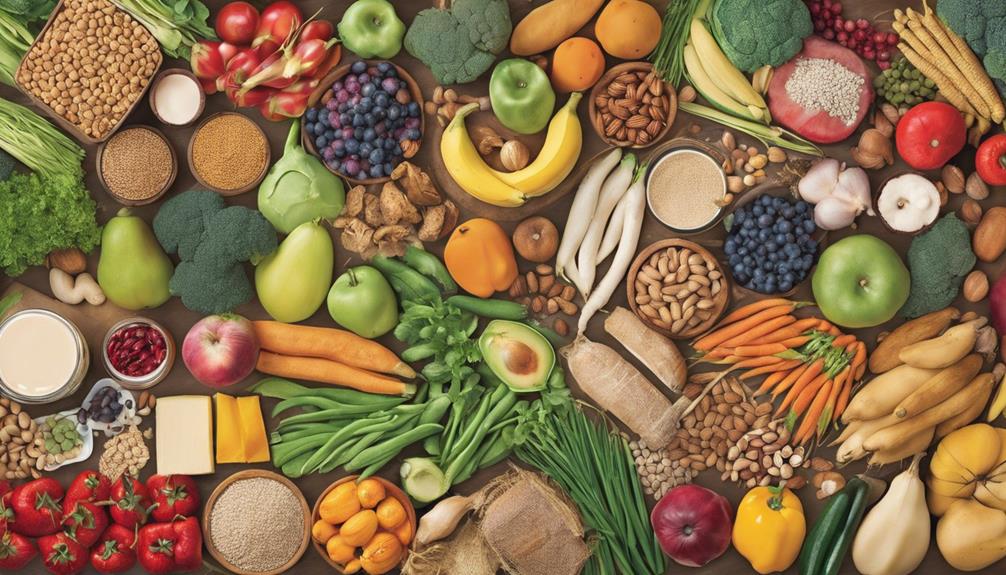So, you ever wondered how tweaking your diet could potentially be a game-changer in soothing your little one's colic?
The Ultimate Breastfeeding Elimination Diet Guide is a reliable resource for unraveling the mysteries behind food sensitivities and their impact on your baby's well-being.
By following the structured approach laid out in this guide, many mothers have successfully navigated through the challenges of identifying and eliminating trigger foods.
But what exactly does this entail, and how can this guide help you find the right balance for your baby's health?
Key Takeaways
- Monitor and document potential allergens in your diet and your baby's reactions.
- Seek advice from a pediatrician before eliminating foods to ensure safety.
- Consider a Total Elimination Diet if individual allergens are hard to pinpoint.
- Maintain balanced nutrition with expert guidance while avoiding allergens.
Understanding Elimination Diets
We recommend starting the process of understanding elimination diets by familiarizing ourselves with the concept and purpose behind this dietary approach. When breastfeeding, it's important to be aware of the potential impact of certain foods on your baby's health.
If your baby displays symptoms such as hives, rashes, or vomiting, it could indicate an allergic reaction to something in your diet. Keeping a detailed food diary and noting any allergic reactions in your baby can help pinpoint the problematic foods. Before making any changes, consulting a pediatrician is vital to guarantee a safe and effective approach.
Elimination diets involve eliminating common allergens like dairy, soy, nuts, and gluten from your diet to see if your baby's symptoms improve. There are two methods: eliminating all suspected allergens at once or removing foods one by one and reintroducing them slowly.
This process helps identify triggers and determine which foods are causing the allergic reactions in your baby. By following these steps and working closely with your healthcare provider, you can tailor your diet to support your baby's health while breastfeeding.
Identifying Trigger Foods

To effectively identify trigger foods in breastfeeding babies, it's essential to remove suspected allergens one at a time and closely monitor the baby's response for any signs of allergic reactions. By following a systematic approach, we can pinpoint the specific foods causing adverse reactions in the baby.
Here are some key steps to help you identify trigger foods:
- Remove One Food at a Time: Exclude suspected trigger foods from your diet individually to assess their impact on the baby.
- Observe Baby's Symptoms: Monitor the baby for any signs of allergic reactions such as eczema, excessive gas, or fussiness.
- Keep a Detailed Food Diary: Document everything you eat and note any changes in the baby's behavior or health.
- Consult a Healthcare Provider: Seek guidance from a healthcare professional to make a safe and effective elimination process.
- Consider Total Elimination Diet: If necessary, you may opt for a Total Elimination Diet under medical supervision to identify hidden food allergens.
Types of Elimination Diets
Elimination diets for breastfeeding mothers involve systematically removing specific allergenic foods from their diet to identify and address potential triggers causing allergic reactions in their babies. There are two main types of elimination diets that can be followed.
The first type involves removing suspected allergens simultaneously from the mother's diet. The second type includes starting foods one at a time to pinpoint the specific allergenic food group causing the baby's health issues.
When a breastfeeding mother consumes food that contains allergenic proteins, these proteins can appear in her breast milk within 3-6 hours, potentially triggering allergic reactions in the baby. Symptoms of allergic reactions in babies may manifest as hives, rashes, vomiting, and more.
Before starting on an elimination diet, it's important to keep a detailed food diary, carefully note any allergic reactions in the baby, and consult a pediatrician for guidance on how to proceed effectively and safely.
Tips for Effective Elimination

When identifying allergenic triggers through elimination diets for breastfeeding mothers, implementing effective elimination strategies is key for success. Here are some tips to help you navigate this process:
- Check Food Labels Carefully: Make sure you meticulously check food labels to avoid hidden allergens that could interfere with your elimination diet.
- Verify Medications and Supplements: Remember to verify medications and supplements for hidden ingredients that may contain allergens.
- Be Prepared to Exclude Multiple Allergens: If necessary, be ready to exclude multiple allergens simultaneously for a more thorough elimination diet.
- Consistency is Key: Stay consistent in avoiding allergens and diligently tracking any reactions to pinpoint triggers accurately.
- Stay Patient and Persistent: Understand that effective elimination takes time and persistence, so be patient with the process.
Balancing Nutrition While Eliminating
A key aspect to take into account while undertaking an elimination diet for breastfeeding is the importance of maintaining a balanced nutrition profile. It's vital to guarantee that you're still receiving all the necessary nutrients for both you and your baby while eliminating potential allergenic foods.
Consulting a dietitian can be beneficial in creating a meal plan that meets your specific nutritional needs during this time. Focus on incorporating nutrient-dense foods such as leafy greens, nuts, seeds, and lean proteins to help maintain ideal nutrition levels.
Monitoring your vitamin and mineral levels is essential to address any deficiencies that may arise from cutting out certain food groups. Exploring alternative sources of nutrients can help you maintain a well-rounded diet while avoiding allergens.
Frequently Asked Questions
How Do I Start an Elimination Diet While Breastfeeding?
We start an elimination diet while breastfeeding by first tracking our diet and baby's symptoms. Consulting experts helps guide the process. Eliminate common allergens for two weeks, then reintroduce one food every four days while monitoring reactions.
What Should I Eat When Starting an Elimination Diet?
When starting an elimination diet, focus on nourishing foods like range-fed turkey, lamb, potatoes, rice, millet, squash, pears, and rice-based beverages. These items are least allergenic and can aid in identifying trigger foods for your baby's symptoms.
What Foods to Cut Out Breastfeeding?
We typically eliminate dairy, eggs, soy, nuts, wheat, and citrus fruits while breastfeeding. It's advised to wait 2 weeks after cutting a food group to monitor changes. Reintroduce one food at a time for accurate identification of trigger foods.
How Long After Cutting Out Dairy Will Breastfed Baby Feel Better?
Once dairy is eliminated from the mother's diet, babies may start feeling better within a few days to a week. Improvement in symptoms like colic or reflux can show the effectiveness of dairy elimination.
Conclusion
To summarize, the Ultimate Breastfeeding Elimination Diet Guide is a valuable resource for mothers seeking to identify and eliminate trigger foods for their colicky babies.
Did you know that up to 40% of infants may have food sensitivities that can be alleviated through dietary changes?
By following this guide and working closely with healthcare professionals, mothers can improve their baby's health and well-being through a carefully crafted elimination diet.










